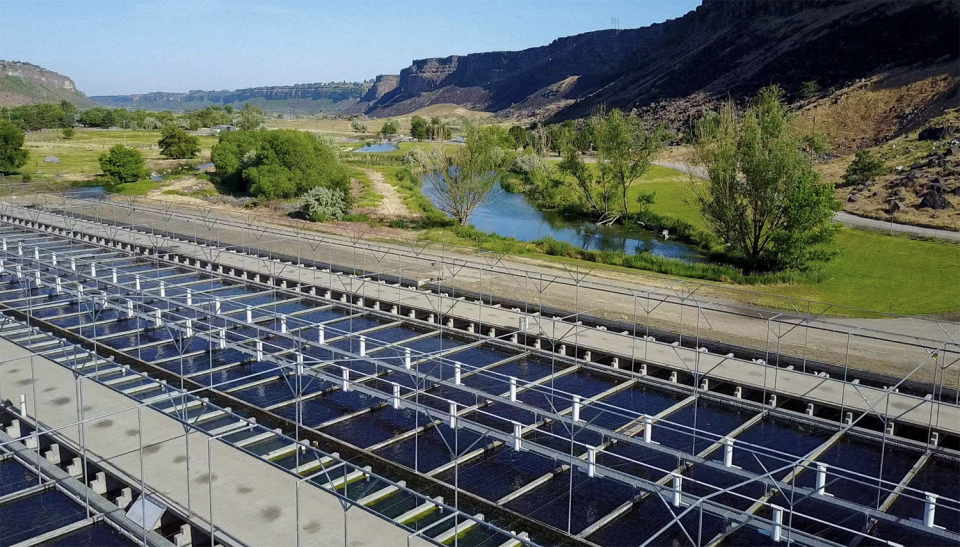With strong production and a product that checks a lot of boxes, U.S. trout producers feel prime time awaits

If there’s any fish in need of greater appreciation, it may be the humble trout. Boasting a bright red-orange and oil-rich fillet like the ever-popular salmon, trout can be grown to market size faster and is often less expensive than its larger cousin.
But boasting has never been a strong suit for trout farmers, some of which have only produced fish for restocking efforts, such as Mt. Lassen Trout Farm in Red Bluff, Calif. Founded in 1949, the boutique producer raises steelhead and trout both as a stocking supplier for the recreational fishing industry and to nearby consumers in Northern California. It recently gave a makeover to its business model by investing in a processing facility and by forging plans to distribute its product in other markets.
“Mt. Lassen has always had a foot in the seafood business, but through a wholesaler in the Bay Area,” explained David Mergle, owner of Aquacraft Brand Portfolio, which Mt. Lassen hired to build a marketing strategy. “The company was losing visibility when the fish left the water, and they realized that if they were going to be in this business, they had to control the packing, processing and their involvement with the customer. They needed to become way more engaged in the marketplace.”
https://www.aquaculturealliance.org/advocate/bizarre-foods-star-andrew-zimmern-aquaculture-helps-save-our-planet/
Some in the marketplace wholeheartedly agree that trout needs a stronger retail presence. Joseph Sabbagh, president of the seafood consultancy Sax Maritime Associates in Calabasas, Calif., told the Advocate that North American farmed trout is not just underappreciated, it’s undervalued.
“The trout industry needs to tell a better story on its long history, its quality and its local attributes as a U.S.-produced species,” he said. “And the people in charge need to have a realistic view of the marketplace and to think about marketing in a very different way.”
Case in point: Mergle’s job will be to freshen up Mt. Lassen’s story, elevate the company’s work and connect them to customers with an eye to careful expansion into other parts of the United States, beyond California. The company produces nearly 1 million pounds of fish a year.

In Idaho, Riverence Provision, which acquired Clear Springs Foods in March 2020, is now the largest land-based producer of trout in the Americas – its combined 14 farms produce more than 15,000 metric tons of trout annually. Riverence produces red-meat trout, which competes with salmon, and white-meat trout, which competes with catfish and tilapia, as well as selling broodstock to other growers.
Chief Brood Officer Sean Nepper said the advantage of trout over salmon is the portion size: “Salmon is a huge filet that’s portioned and sold, but we sell a whole side of trout as a 9-12-ounce filet. For the consumer that means you get the benefit of a full filet, the loin, the belly, etc., whereas with a portion of salmon you just get a section of the filet,” he said. “On the plate, it looks different, too. So we push the 9-12 ounce filet of trout and that’s the direction we want to move in.”
Nepper said it takes between 11 and 14 months for Riverence trout to reach market size. The company hopes to grow its direct-to-consumer sales in future months and what was once Clear Springs is now called Riverence Provision.
“David Kelley, owner of Riverence, is a tremendous storyteller and I think he has a passion for the seafood industry,” Sabbagh said. “But I’m concerned about his ability to manage his passion with the realities of the industry, which remains a highly competitive, low-margin business that is sadly based upon price. Many people new to the industry sometimes let their passions run away and hire people that support those passions, instead of understanding the nature of the industry.”
In selling broodstock, Riverence Brood competes directly with Troutlodge, a Bonney Lake, Washington business that began in 1945 and is now the world’s largest supplier of trout eggs. Acquired by the Hendrix Genetics Group in 2016, it includes eight facilities in Washington State and Idaho, with freshwater subsidiaries in the Isle of Man and a sister company producing trout eggs in Chile since 1996.
“We sell half a billion eggs annually and export to 60 different countries,” said Sam Bowman, a consultant with the company. “While we haven’t had a big foothold in Europe due to competitors in Italy and France, we’re making inroads into Iran, Turkey and Russia. And North America is a big market for us, too.”
Bowman said demand for the company’s eggs is increasing as trout consumption grows. He estimates trout production in North America to be between 35,000 and 40,000 tons annually, as compared to salmon production at 150,000 tons. He added that as interest in land-based production increases, Hendrix Genetics is helping its customers create new land-based facilities where they can establish and manage trout breeding programs.
Some producers are looking outside of North America for their eggs. Juan Gutierrez, CEO of Emerald Trout in Colombia, purchased a trout farm near Bogota in December 2020, and soon thereafter negotiated with a Danish producer to import two million eggs a year. He uses them at Emerald Trout and sells to other producers.
“The Danish have worked hard to ensure their eggs are more resistant to disease and have lower mortality, and everyone we’ve sold to says they’ve never seen eggs as big as ours,” he noted. “By providing higher quality eggs in Colombia we’ve made the competition step up and they’re selling better quality eggs now too. So it’s helped the industry a lot.”
Gutierrez is working on increasing his capacity and establishing a processing facility that he’ll share with other producers. He’s also trying to obtain the certifications necessary to export to the United States, Europe and Japan. Grow-out time for his trout is just seven months and he plans to produce 1,000 metric tons a year by 2026, up from 144 metric tons today.
He hopes to target the market for whole fresh imports into the U.S. market, which is worth $78 million annually, according to figures he credits to Sicex, a firm that conducts market analyses.
“Colombia is very experienced at exporting fresh fish – we export $200 million per year. But we also export a billion dollars of flowers, and no-one eats flowers,” he said. “My vision is to build up this country’s aquaculture sector because we are more than capable of exporting a billion dollars of fish a year.”
Follow the Advocate on Twitter @GAA_Advocate
Now that you've reached the end of the article ...
… please consider supporting GSA’s mission to advance responsible seafood practices through education, advocacy and third-party assurances. The Advocate aims to document the evolution of responsible seafood practices and share the expansive knowledge of our vast network of contributors.
By becoming a Global Seafood Alliance member, you’re ensuring that all of the pre-competitive work we do through member benefits, resources and events can continue. Individual membership costs just $50 a year.
Not a GSA member? Join us.
Author
-

Lauren Kramer
Vancouver-based correspondent Lauren Kramer has written about the seafood industry for the past 15 years.

